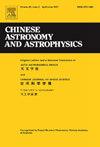明安图光谱日光照相仪图像的强度定标
Q4 Physics and Astronomy
引用次数: 0
摘要
MUSER是新一代太阳专用射电成像光谱望远镜,在0.4 - 15ghz超宽带频率范围内实现了对太阳的高时间、高角度、高分辨率成像。射电亮温是描述太阳物理过程的一个重要参数。它在研究各种射电辐射机制、太阳磁场和太阳爆发期间非热粒子的加速方面发挥着重要作用,使亮度温度校准成为射电日像仪图像的必要条件。本文介绍了一种适用于定标日光照相图像强度的方法。考虑到太阳射电图像包含了太阳盘的结构信息,可以利用第一类贝塞尔函数与射电日像仪短基线的能见度拟合得到安静太阳盘的射电半径和强度。随后,利用瑞利-金斯定律和日太阳射电通量计算日图像的定标因子Gc,从而实现射电日像仪图像强度定标。将该方法应用于MUSER的实际观测数据,包括安静太阳和太阳射电暴等场景,结果表明,每日校准因子Gc的误差在其值的10%以内,得到的安静太阳的亮度温度与其他研究结果有很强的相关性。这些结果表明了该方法的可行性和有效性。本文章由计算机程序翻译,如有差异,请以英文原文为准。
Intensity Calibration for the Mingantu Spectral Radioheliograph Images
The MUSER, a new generation of solar-dedicated radio imaging spectroscopic telescope, has achieved high-time, high-angular, and high-frequency resolution imaging of the Sun within the 0.4–15 GHz ultra-broadband frequency range. The radio brightness temperature is a critical parameter in describing solar physical processes. It plays a significant role in studying various radio radiation mechanisms, the solar magnetic field, and the acceleration of non-thermal particles during solar bursts, making brightness temperature calibration essential for radioheliograph images. This paper introduces a method suitable for calibrating the intensity of radioheliograph images. Given that solar radio images contain structural information about the solar disk, the radio radius and intensity of the quiet solar disk can be obtained by fitting Bessel function of the first kind with the visibilities of short baselines from the radioheliograph. Subsequently, the Rayleigh-Jeans law and the daily solar radio flux are used to calculate the calibration factor for the daily image, thereby achieving image intensity calibration of the radioheliograph. Applying this method to actual observation data from MUSER, including scenarios such as the quiet Sun and solar radio bursts, shows that the error of the daily calibration factor is within 10% of its value, and the obtained brightness temperature of the quiet Sun strongly correlates with results from other studies. These results indicate the method's feasibility and effectiveness.
求助全文
通过发布文献求助,成功后即可免费获取论文全文。
去求助
来源期刊

Chinese Astronomy and Astrophysics
Physics and Astronomy-Astronomy and Astrophysics
CiteScore
0.70
自引率
0.00%
发文量
20
期刊介绍:
The vigorous growth of astronomical and astrophysical science in China led to an increase in papers on astrophysics which Acta Astronomica Sinica could no longer absorb. Translations of papers from two new journals the Chinese Journal of Space Science and Acta Astrophysica Sinica are added to the translation of Acta Astronomica Sinica to form the new journal Chinese Astronomy and Astrophysics. Chinese Astronomy and Astrophysics brings English translations of notable articles to astronomers and astrophysicists outside China.
 求助内容:
求助内容: 应助结果提醒方式:
应助结果提醒方式:


